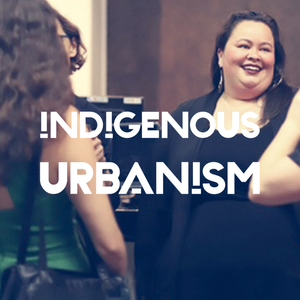
EPISODE SUMMARY: On this episode of Indigenous Urbanism, we speak with Elisapeta Heta nō Ngāti Wai, an architectural graduate working at Jasmax. Elisapeta is also an artist and academic, and has held various significant advocacy roles.
GUESTS: Elisapeta Heta
FULL TRANSCRIPT:
Jade Kake: Tēnā koutou katoa
Nau mai haere mai ki te Indigenous Urbanism, Aotearoa Edition, Episode 7.
I’m your host Jade Kake and this is Indigenous Urbanism, stories about the spaces we inhabit, and the community drivers and practitioners who are shaping those environments and decolonising through design.
On this episode of Indigenous Urbanism, we speak with Elisapeta Heta nō Ngāti Wai, an architectural graduate working at Jasmax. Elisapeta is also an artist and academic, and has held significant advocacy roles, including her previous role as Co-Chair of Architecture Women, and current role as the Ngā Aho representative to the New Zealand Institute of Architects Board.
We caught up with Elisapeta at the Jasmax offices in Parnell.
JK: Ko wai koe? Nō hea koe? Where are you from, and who are you?
Elisapeta Heta: I am from many places actually. On my father's side I'm from up north, and a little bit south of here, so nō Ngāti Wai ahau, me Waikato-Tainui, and on my mother's side I am Samoan, Tokelauan, and English. So she's first generation New Zealander, whatever that means. Her mother was born in Apia, and her father was born in Portsmouth in England. So, from everywhere. Ko Elisapeta Hinemoa Heta ahau. I'm an architectural graduate at Jasmax, but I'm also part of a roopu here called Waka Maia. We are three architectural graduates, who run a lot of the - for want of better words - Māori navigation type stuff for projects. So we have boldly given ourselves the title of Kaihautū Whaihanga, so Māori design leaders within the practice.
JK: And so you find yourself in a really large firm, being one of a few Māori practitioners. So could you talk a little bit, just about that experience.
EH: Yeah, for me, for starters, it's quite funny as a graduate I think you sort of assuming you are going out into the world begging somebody to take you on as some kind of strange liability to them, or something. But I was very deliberate about choosing to want to come and work with Jasmax. And that was partly because Jasmax had a known reputation for working on community projects that involved Māori that I was really intrigued by. A lot of that was led and run by Ivan Mercep, who's since passed away. But he had quite the legacy, effectively, with Māori communities, with Māori projects. Even though he wasn't Māori himself, and had mentored Brendan Himona and sort of a little bit at the end there as well, Rameka Tu'inukuafe, who are both my colleagues in Waka Maia. Jasmax I think, sort of had a cultural capacity, shall we say. It had an understanding. It had a bit of - when I sort of found out the history of why Jasmad began, little bit of a radical sort of beginnings, and wanting to make the city a better place. And I suppose that's considered radical sometimes.
JK: Shockingly
EH: Shockingly, yeah. Protesting against motorways being built in ridiculous places, and all sorts of things like that. So, I think Jasmax just had, there was an inbuilt sort of sense for me, from the outside looking in, that it was something I could get in on. It's hard, I think, to build cultural capacity from scratch. Knowing that there were Māori colleagues already here that were trying to make things happen, that was sort of a nice transition, I suppose. It had some momentum, it had some legs. I came on at a time that Haley Hooper, another Māori wahine, had also joined Jasmax only six months prior to me starting here, so there ended up being four of us, which was a little bit of a bubble. And we, I think in sort of a momentum, kind of riding the wave of a whole lot of things happening outside of the office. So, the first time Māori had ever met officially with the NZIA had happened at the same time, and there were talks about the kawenata which eventually comes into being later on, I suppose, in the chronology of my life. So, being here, or coming here to Jasmax was kind of wanting to push myself where I thought was really important, with the kind of powerhouse that this already had, I suppose. Nothing's perfect, everybody, every group, every collective, every office, has things they can do better. I think that's what's been pretty amazing, personally from my point of view, is the willingness of this office to actually let us roam a little bit far, and then come back, and sort of genuinely start to initiate and embed a lot of the things that we thought were important from a te ao Māori point of view into business as usual at this practice. Which is pretty amazing, steering a ship of - you know last year it was over 300 people. So, you'd think change like that would take a lo...
08/02/18 • 33 min
Generate a badge
Get a badge for your website that links back to this episode
<a href="https://goodpods.com/podcasts/indigenous-urbanism-68738/in-conversation-with-elisapeta-heta-3641844"> <img src="https://storage.googleapis.com/goodpods-images-bucket/badges/generic-badge-1.svg" alt="listen to in conversation with elisapeta heta on goodpods" style="width: 225px" /> </a>
Copy